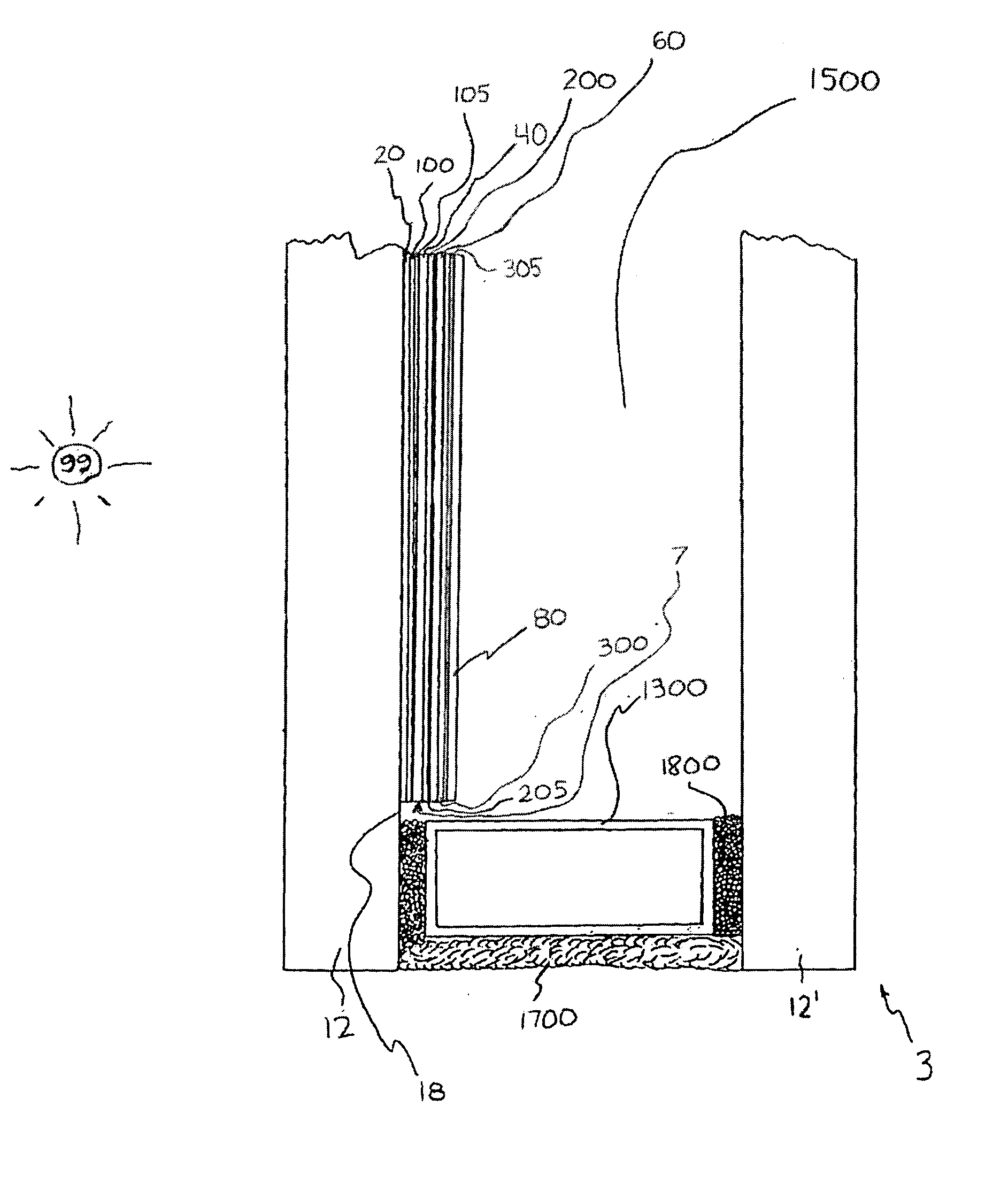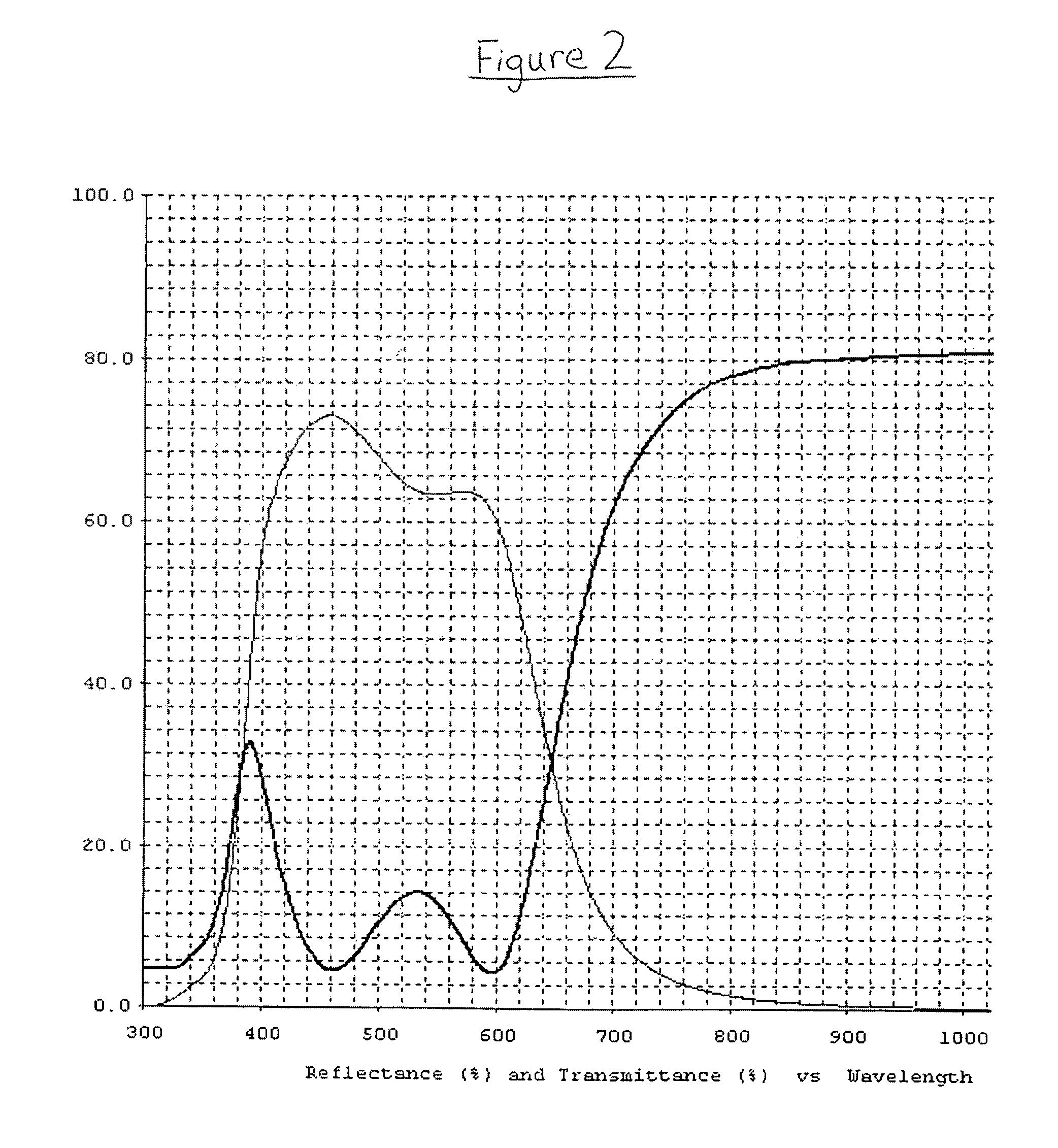[0006] In certain embodiments, the invention provides a transparent substrate having two generally opposed major surfaces with a multiple cavity low-emissivity coating on a desired one of the major surfaces. The coating comprises, in sequence from the desired major surface outwardly, a first transparent dielectric film region, a first infrared-reflection film region, a second transparent dielectric film region, a second infrared-reflection film region, a third transparent dielectric film region, a third infrared-reflection film region, and a fourth transparent dielectric film region. In the present embodiments, the coating has a metal / dielectric ratio of at least 0.22. The metal / dielectric ratio is defined as the combined thickness of the first, second, and third infrared-reflection film regions divided by the combined thickness of the first, second, third, and fourth transparent dielectric film regions.
[0007] Some embodiments of the invention provide a transparent substrate having two generally opposed major surfaces with a multiple cavity low-emissivity coating on a desired one of the major surfaces. The coating comprises, in sequence from the desired major surface outwardly, a first transparent dielectric film region, a first infrared-reflection film region, a second transparent dielectric film region, a second infrared-reflection film region, a third transparent dielectric film region, a third infrared-reflection film region, and a fourth transparent dielectric film region. In the present embodiments, the coating preferably has a metal / dielectric ratio of at least 0.25. The metal / dielectric ratio is defined as the combined thickness of the first, second, and third infrared-reflection film regions divided by the combined thickness of the first, second, third, and fourth transparent dielectric film regions. Preferably, the transparent substrate is part of a multiple-pane insulating glazing unit that includes a second pane, the unit has at least one between-pane space, and the desired major surface is exposed to a between-pane space of the unit. In the present embodiments, the insulating glazing unit preferably has an exterior reflected color characterized by an ah color coordinate of between about +1.5 and about −2 and a bh color coordinate of between about 0 and about −3.
[0008] Certain embodiments of the invention provide a transparent substrate having two generally opposed major surfaces with a multiple cavity low-emissivity coating on a desired one of the major surfaces. The coating comprises, in sequence from the desired major surface outwardly, a first transparent dielectric film region, a first infrared-reflection film region, a second transparent dielectric film region, a second infrared-reflection film region, a third transparent dielectric film region, a third infrared-reflection film region, and a fourth transparent dielectric film region. In the present embodiments, the coating preferably has a metal / dielectric ratio of at least 0.25. The metal / dielectric ratio is defined as the combined thickness of the first, second, and third infrared-reflection film regions divided by the combined thickness of the first, second, third, and fourth transparent dielectric film regions. Preferably, the transparent substrate is part of a multiple-pane insulating glazing unit that includes a second pane, the unit has at least one between-pane space, and the desired major surface is exposed to a between-pane space of the unit. In the present embodiments, the insulating glazing unit preferably has a visible transmittance of 0.65 or more.
[0009] In certain embodiments, the invention provides a glass pane having two generally opposed major surfaces with a multiple cavity low-emissivity coating on a desired one of the major surfaces. The coating comprises, in sequence from the desired major surface outwardly, a first transparent dielectric film region, a first layer comprising silver, a second transparent dielectric film region, a second layer comprising silver, a third transparent dielectric film region, a third layer comprising silver, and a fourth transparent dielectric film region. In the present embodiments, the coating has a metal / dielectric ratio of at least 0.22. The metal / dielectric ratio is defined as the combined thickness of the first, second, and third layers comprising silver divided by the combined thickness of the first, second, third, and fourth transparent dielectric film regions. Preferably, the glass pane is part of a multiple-pane insulating glass unit that includes a second glass pane, the unit has at least one between-pane space, and the desired major surface is exposed to a between-pane space of the unit. In the present embodiments, the insulating glass unit preferably has an exterior reflected color characterized by a chroma magnitude number of less than about 1.82. In some of the present embodiments, the metal / dielectric ratio is at least 0.25. Optionally, the first, second, and third layers comprising silver each have a thickness of between about 75 angstroms and about 275 angstroms. Additionally or alternatively, the first, second, third, and fourth transparent dielectric film regions can optionally each have a total physical thickness of between about 100 angstroms and about 800 angstroms. In some cases, the first, second, and third layers comprising silver each have a thickness of between about 100 angstroms and about 250 angstroms. Additionally or alternatively, the first, second, third, and fourth transparent dielectric film regions can optionally each have a total physical thickness of between about 50 angstroms and about 900 angstroms. In some of the present embodiments, the coating has only two cavities including a first cavity between the first and second layers comprising silver and a second cavity between the second and third layers comprising silver, with each of these two cavities optionally having a thickness of between about 300 angstroms and about 850 angstroms, or perhaps between about 400 angstroms and about 750 angstroms.
 Login to View More
Login to View More 


